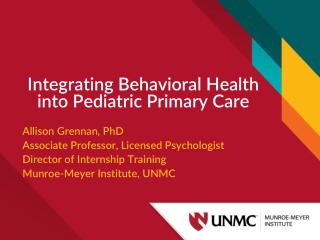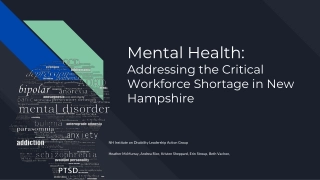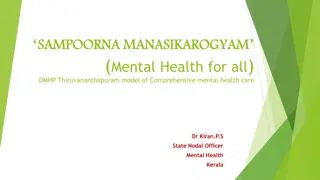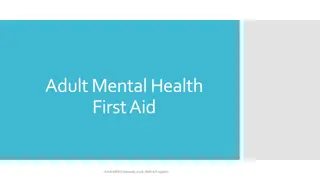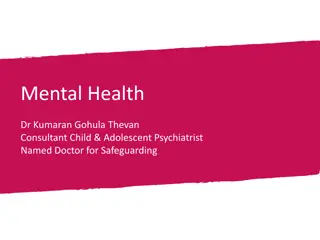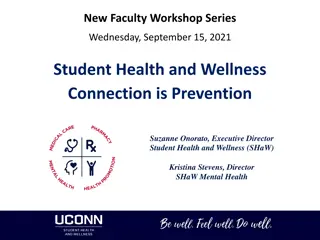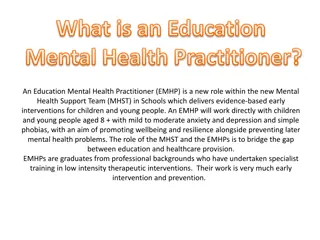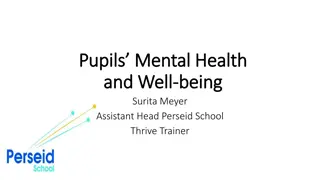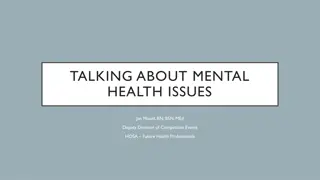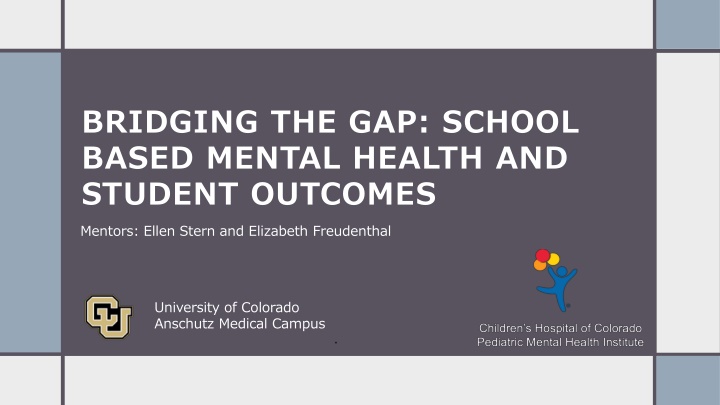
Investigating Barriers to Implementing School-Based Mental Health Systems
Explore the impact of school-based mental health programs on student outcomes post-COVID-19 pandemic. Analyze the correlation between school psychologists and graduation rates, while investigating alternative initiatives for mental health support in schools.
Download Presentation

Please find below an Image/Link to download the presentation.
The content on the website is provided AS IS for your information and personal use only. It may not be sold, licensed, or shared on other websites without obtaining consent from the author. If you encounter any issues during the download, it is possible that the publisher has removed the file from their server.
You are allowed to download the files provided on this website for personal or commercial use, subject to the condition that they are used lawfully. All files are the property of their respective owners.
The content on the website is provided AS IS for your information and personal use only. It may not be sold, licensed, or shared on other websites without obtaining consent from the author.
E N D
Presentation Transcript
BRIDGING THE GAP: SCHOOL BASED MENTAL HEALTH AND STUDENT OUTCOMES Mentors: Ellen Stern and Elizabeth Freudenthal University of Colorado Anschutz Medical Campus
Student outcomes can be proximal or distal, across skills, behaviors, and attitudes, all measured and observed on an individual scale. For example: - proximal behavior would include observations of a student doing an instructed task - a distal skill would include course grades, or performance on broad, standardized tasks.
After the COVID-19 Pandemic, youth anxiety and depression rates have doubled. School based mental health systems have become a critical point of access for youth experiencing mental health issues. Schools can recognize early or current symptoms, as they manage students for most of their day.
The graph illustrates the correlation between school psychologists and graduation rates.
PROJECT AIM: TO INVESTIGATE THE BARRIERS OF IMPLEMENTING SCHOOL BASED MENTAL HEALTH SYSTEMS AND ITS EFFECT ON YOUTH BY ANALYZING STUDENT OUTCOMES.
If school psychologists are too difficult to administer, what other initiatives are available?
METHODS- LEGISLATION
Nationwide Initiatives Greenlights Grant Initiative Navigation and resource point for school safety grant processes. Ensures equitable federal funding. Raises awareness of school safety. TCHATT Program (Texas) Delivers free telemedicine for students to identify and assess mental health needs Provides access to mental health services. Allows students into care instead of waiting months to access a service provider. Addresses stigma around mental health.
Nationwide Initiatives Wellness Checks In School Programs Act (Illinois) Implements wellness checks to identify students grades 7-12, including school districts with high percentage of Medicaid and referrals. Establishes a referral process for immediate intervention for students identified as having a behavioral health issue that requires intervention. Bipartisan Safer Communities Act BSCA emphasizes proactive crime prevention strategies, community engagement, and partnerships between law enforcement agencies and local organizations. Provides resources and support to strengthen law enforcement capabilities. Highlights the importance of accessible mental health and substance abuse treatment to address underlying issues contributing to criminal behavior.
Children's System of Care Serves as the single point of access to address the behavioral health needs of children and youth in Colorado, regardless of payer, insurance, and income. I Matter Colorado House Bill 21-1258: Provides access to mental health and substance use disorder services for youth. Addresses needs that may have resulted from the COVID-19 pandemic. COLORADO
Medicaid Disenrollment Crisis Flaws in connecting patients with insurance despite qualification leaves providers uncompensated and patients without necessary treatment. o During COVID-19, state agencies were required to provide coverage, regardless of eligibility. After COVID-19, a significant number (~30%) of qualified members lost coverage. Why does this matter?
METHODS- SURVEY
HEALTHY KIDS COLORADO SURVEY (HKCS) 26% of youth reported persistent feelings of sadness or hopelessness in the past year (decrease from 40% in 2021). 11% of youth seriously considered suicide in the past year (decrease from 17% in 2021). 19% of youth could fire a loaded gun without adult permission in less than an hour.
METHODS- LITERATURE REVIEW
Children with externalizing symptoms in elementary school tend to have worse outcomes in life. The internalizing symptoms only increased into adulthood. Academic improvement in students has been linked to services that support social emotional functioning, whether that be prevention or therapy. Students who excel in social and behavioral areas targeted by SEL (social emotional learning) programs scored higher on the Washington Assessment of Student Learning (WASL) than students with high levels of substance use, attention problems, depression, and antisocial behavior.
MENTAL HEALTH AND STUDENT OUTCOMES HAS SHOWN TO BE A BIDIRECTIONAL RELATIONSHIP. IF SCHOOLS CENTER STUDENT ENGAGEMENT ACROSS SOCIAL AND EMOTIONAL LEARNING, SCHOOLS MAY PERFORM BETTER ACADEMICALLY, WHICH IN TURN CAN REWARD THEM WITH MORE FUNDING. FUNDING IS AN OBSTACLE ACROSS SCHOOLS AND LEGISLATION. SCHOOL DISTRICTS HESITATE TO IMPLEMENT PROGRAMS FOR A VARIETY OF REASONS, INCLUDING TRUST IN CONTINUOUS FUNDS, DELEGATION OF PROGRAM REQUIREMENTS, AND GRANT PROCESSES. EX. GREENLIGHTS GRANT INITIATIVE, TCHATT PROGRAM
The data for expulsion/suspension available did not include title 1 or at-risk schools, but instead separated by gender, race/ethnicity, or ELL, special needs, or 504 statuses. Limitations Because education data was restricted and often had missing or unrelated info, it was difficult to correlate school psychologists and similar access points to students' academic success.
FUTURE IMPLICATIONS/NEXT STEPS
EXPAND STUDENT SUCCESS OUTSIDE OF ACADEMIC OUTCOMES. INVEST IN EARLY PREVENTION STRATEGIES, FOSTERING HEALTHY RELATIONSHIPS WITH CAREGIVERS, TRUSTED ADULTS, AND THE COMMUNITY. INCREASE ACCESS POINTS FOR YOUTH, INCLUDING SCHOOL PSYCHOLOGISTS, COUNSELORS, AND SOCIAL WORKERS. REMOVE BARRIERS TO CARE, REGARDLESS OF INCOME OR INSURANCE PROVIDERS CREATE HEALTHY ENVIRONMENTS FOR YOUTH, PROMOTING SAFE DISCUSSIONS SURROUNDING MENTAL HEALTH. IMPLEMENT BETTER FRAMEWORKS BETWEEN LEGISLATIVE, POLITICAL, AND EDUCATIONAL SYSTEMS.
SPECIAL THANKS TO: Dr. Ron-Li Liaw, Chair of PMHI Dr. Neill Epperson, Chair of Department of Psychiatry Dr. Dominic Martinez, Dir. Office of Inclusion and Outreach, CCTSI Ellen Stern, Director of Government Affairs Elizabeth Freudenthal, Senior Medicaid Consultant Yunliang (Lily) Luo, Director PURPLE Program Shanna Trott, Director PURPLE Program Dr. Merlin Ariefdjohan, PURPLE Program Founder and Faculty Advisor

